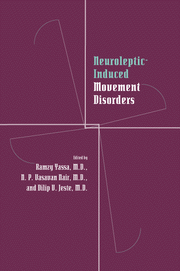Book contents
- Frontmatter
- Contents
- Contributors
- Preface
- Part I Historical perspective
- Part II Clinical aspects of tardive dyskinesia
- Part III Mechanisms underlying tardive dyskinesia
- Part IV Measurement of tardive dyskinesia
- Part V Tardive dyskinesia in different populations
- Part VI Other neuroleptic-induced movement disorders
- 24 Drug-induced parkinsonism
- 25 Clinical aspects of neuroleptic-induced dystonia
- 26 Tardive dystonia
- 27 Tardive akathisia
- Part VII Treatment of tardive dyskinesia
- Index
24 - Drug-induced parkinsonism
from Part VI - Other neuroleptic-induced movement disorders
Published online by Cambridge University Press: 09 October 2009
- Frontmatter
- Contents
- Contributors
- Preface
- Part I Historical perspective
- Part II Clinical aspects of tardive dyskinesia
- Part III Mechanisms underlying tardive dyskinesia
- Part IV Measurement of tardive dyskinesia
- Part V Tardive dyskinesia in different populations
- Part VI Other neuroleptic-induced movement disorders
- 24 Drug-induced parkinsonism
- 25 Clinical aspects of neuroleptic-induced dystonia
- 26 Tardive dystonia
- 27 Tardive akathisia
- Part VII Treatment of tardive dyskinesia
- Index
Summary
Descriptions of drug-induced parkinsonism (DIP) began to appear early in the decade that followed the introduction of antipsychotic medications (Lehmann & Hanrahan, 1954; Hall, Jackson, & Swain, 1956; Deniker, 1960; Kruse, 1960; Goldman, 1961; McGeer et al., 1961; Ayd, 1961; Simpson et al., 1964). DIP is one of the most common side effects of antipsychotic medications. Although other syndromes may have received more attention, because of their apparent irreversibility or because of novelty of presentation, DIP probably causes the greatest morbidity. This chapter will review the typical clinical presentation, differential diagnosis, epidemiology, evaluation, pathophysiology, and treatment for this major iatrogenic problem.
Clinical Presentation
Description of the Syndrome
All the cardinal signs of idiopathic Parkinson's disease (IPD) occur in DIP (Hall et al., 1956; Lader, 1970; Goetz & Klawans, 1981; Rajput, 1984; Casey, 1991; Friedman, 1992). Although some authors have used the term “pseudoparkinsonism” to describe DIP, given that DIP and IPD appear to have the same symptoms and basic biochemical mechanism, that term is no longer favored. The signs of DIP can be grouped into five categories: bradykinesia, rigidity, tremor, loss of postural reflexes, and a miscellaneous category. This grouping of specific motor signs is somewhat arbitrary, for the causes of the signs cannot always be determined, and the groups are not entirely independent.
- Type
- Chapter
- Information
- Neuroleptic-induced Movement DisordersA Comprehensive Survey, pp. 341 - 380Publisher: Cambridge University PressPrint publication year: 1996



